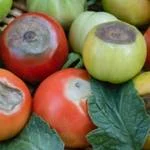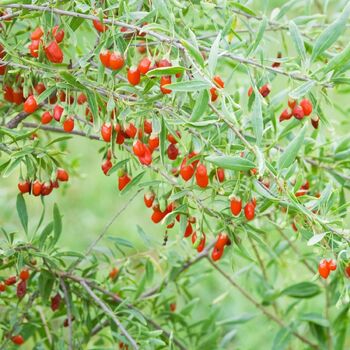
How to Grow Goji Berry Seeds
Grow Guide #2496
Family: Solanaceae
Binomial name: Lycium barbarum
Life Cycle: Perennial
This 'How to Grow' guide details everything a home gardener needs to know to plant, grow and care for Goji berries (Lycium barbarum).
When to Sow Goji berry Seeds
Goji berry is a perennial plant that grows year round in most climates. Use the table below to identify the best time of year to sow goji berry seeds in your climate.
| JAN | FEB | MAR | APR | MAY | JUN | JUL | AUG | SEP | OCT | NOV | DEC | |
|---|---|---|---|---|---|---|---|---|---|---|---|---|
| Cool | ||||||||||||
| Temperate | ||||||||||||
| Sub-Tropical | ||||||||||||
| Tropical | ||||||||||||
| Arid |
Preparation
Goji berry plants are perennial, meaning they live for several years. Choose a permanent position where plants can grow undisturbed by regular digging.
Goji berry plants are best grown in full sun or part shade. Choose a location that will receive at least 3 hours of full sun each day.
Goji berry plants commonly grow suckers, new shoots that grow from the roots of an established plant. Choose a position where plants can spread over time. If you do not want goji berries to become established in your garden, control suckers by breaking them off below soil level or grow goji berry in a container.
Goji berry plants can be grown in containers. If possible choose a variety that’s recommended for container growing. Use a good quality potting mix and make sure your container is large enough for mature plants; a minimum of 40 litres is recommended for goji berries. During the growing season, keep in mind that container grown plants may need additional fertiliser to encourage healthy growth.
How to Sow Goji berry Seeds
Goji berry seeds do not require any treatment (eg soaking, stratification) before sowing.
Goji berry seeds can be sown directly into the garden OR seedlings can be raised in trays or other containers and transplanted to the garden once established.
Sow Direct
- Sow seeds directly in the garden 8mm deep and 200cm apart.
- Keep soil moist but never wet or dry.
- Seeds should germinate in around 14-28 days at a soil temperature of 20-25°C.
- Young seedlings will need protection from pests, pets and weather until they are established.
Raise Seedlings
- Fill trays, punnets or jiffy pots with a good quality seed-raising mix, or use soil starter pellets.
- Sow seeds 8mm deep.
- Keep soil moist but never wet or dry.
- Seeds should germinate in around 14-28 days at a soil temperature of 20-25°C.
- Transplant seedlings to the garden once they have their first true leaves and are large enough to handle (usually 5-10cm tall).
- Plant out, spacing plants 200cm apart.
Tip: Seeds of this variety can be slow to germinate. Take note of the expected germination time, be patient and follow the recommended depth and temperature guidelines closely for the best chance of success.
Goji berry seedlings are sensitive to frost. In cool climates goji berry seeds can be sown indoors 6 weeks before the last expected frost. Grow them in a warm position with plenty of natural light.
How to Grow Goji berry
Goji berry plants may need watering during the growing season. Water when the soil is dry about 5cm below the surface (test this by scratching away a little soil with your finger). Water deeply in the early morning or late afternoon. Avoid watering the leaves of plants to avoid fungal diseases. Learn more about watering here.
Goji berry plants will grow in nutrient-poor soils and do not need additional fertiliser during the growing season.
Goji berry plants may die back in cold weather. Cut plants back just above ground level in late autumn, or prune off dead foliage when new leaves emerge in spring.
How to Harvest Goji berries
Goji berries should be ready to harvest in approximately 90-110 days. Maximum production is reached when plants are 3 to 5 years old.
Goji berries are ready to harvest when they are fully coloured. Harvest pods by cutting with snips/secateurs. Harvest regularly to encourage more pods. Goji berries can be eaten fresh, juiced, frozen or dried. To dry, lie berries in a single layer on a drying rack in the sun or use a dehydrator.
Common Problems when Growing Goji berries
Like all plants, goji berry is susceptible to some pests, diseases and other problems. Below is a list of the most common problems gardeners encounter when growing goji berry plants:
 Blossom end rot is a nutrient deficiency caused by a lack of calcium uptake, often due to inconsistent watering. Fruit will discolour from the bottom end upwards, with the affected area growing darker and harder. Dispose of affected fruit, water regularly and evenly, and correct soil pH and nutrients if required. Read more about blossom end rot here.
Blossom end rot is a nutrient deficiency caused by a lack of calcium uptake, often due to inconsistent watering. Fruit will discolour from the bottom end upwards, with the affected area growing darker and harder. Dispose of affected fruit, water regularly and evenly, and correct soil pH and nutrients if required. Read more about blossom end rot here. Possums, birds and other animals can ruin a large percentage of your harvest overnight. Physically exclude pests by using netting or cages, or try spraying plants with a pungent homemade spray made from garlic, fish oil or mustard.
Possums, birds and other animals can ruin a large percentage of your harvest overnight. Physically exclude pests by using netting or cages, or try spraying plants with a pungent homemade spray made from garlic, fish oil or mustard..jpg) Powdery mildew is caused by fungal spores reproducing on the leaves of plants. First showing as white spots on leaves, affected areas can spread quickly to cover the entire leaf surface. While rarely fatal, powdery mildew can reduce yields. Water plants at soil level (not on leaves) to prevent spreading spores, allow good air flow between plants, remove affected leaves and if necessary spray with an appropriate fungicide or homemade spray. Read more here about powdery mildew here.
Powdery mildew is caused by fungal spores reproducing on the leaves of plants. First showing as white spots on leaves, affected areas can spread quickly to cover the entire leaf surface. While rarely fatal, powdery mildew can reduce yields. Water plants at soil level (not on leaves) to prevent spreading spores, allow good air flow between plants, remove affected leaves and if necessary spray with an appropriate fungicide or homemade spray. Read more here about powdery mildew here. Spider mites (Tetranychus urticae), also known as two spotted mites, are sap-sucking arachnids that cause dry, wilted or discoloured leaves. The undersides of leaves may feel dry and a little like fine sandpaper. Prune plants to allow good air flow or spray with eco-oil or wettable sulphur. Learn more about managing spider mites here.
Spider mites (Tetranychus urticae), also known as two spotted mites, are sap-sucking arachnids that cause dry, wilted or discoloured leaves. The undersides of leaves may feel dry and a little like fine sandpaper. Prune plants to allow good air flow or spray with eco-oil or wettable sulphur. Learn more about managing spider mites here.


.png)



